Effect of Pyrolysis Conditions on the MOFs-Derived Zinc-Based Catalysts in Acetylene Acetoxylation
Abstract
:1. Introduction
2. Results and Discussion
2.1. Effect of Different Preparation Conditions on MOFs-Derived Zinc-Based
2.2. Analysis of the Effect of Different Pyrolysis Conditions on MOFs-Derived Zinc-Based
3. Materials and Methods
3.1. Materials
3.2. Catalysts’ Preparation
3.2.1. Preparation of MOF5 Precursor
3.2.2. Preparation of MOF5-700, MOF5-750 and MOF5-800 Catalysts
3.3. Catalysts Characterization
3.4. Catalyst Evaluation
4. Conclusions
Author Contributions
Funding
Data Availability Statement
Conflicts of Interest
References
- Xing, B.; Wei, Z.; Wang, G. Acetate coverage effect on the reactivity of vinyl acetate synthesis on Pd/Au alloy surfaces. J. Energy Chem. 2013, 22, 671–679. [Google Scholar] [CrossRef]
- Zhang, M.; Zhuang, J.; Wu, X.; Yu, Y. Experimental and theoretical insights into the cyclotrimerization of acetylene during vinyl acetate synthesis. Chem. Eng. J. 2019, 378, 122183. [Google Scholar] [CrossRef]
- Dong, X.; Wang, Y.; Yu, Y.; Zhang, M. Density Functional Theory Investigation on the Synthesis Mechanism of Vinyl Acetate from Acetylene and Acetic Acid Catalyzed by Ordered Mesoporous Carbon-Supported Zinc Acetate. Ind. Eng. Chem. Res. 2018, 57, 7363–7373. [Google Scholar] [CrossRef]
- Schobert, H. Production of acetylene and acetylene-based chemicals from coal. Chem. Rev. 2014, 114, 1743–1760. [Google Scholar] [CrossRef]
- El-Sawi, M.; Emig, G.; Hofmann, H. A study of the kinetics of vinyl acetate synthesis. Chem. Eng. J. 1977, 13, 201–211. [Google Scholar] [CrossRef]
- Xu, Z.; He, P.; Chen, Y.; Zhu, M.; Wang, X.; Dai, B. Performance Study of Zn-Co-Ni/AC Catalyst in Acetylene Acetylation. Catalysts 2021, 11, 1271. [Google Scholar] [CrossRef]
- Wang, Z.; Xia, C.; Xia, Y. Dynamic relationship between environmental regulation and energy consumption structure in China under spatiotemporal heterogeneity. Sci. Total Environ. 2020, 738, 140364. [Google Scholar] [CrossRef] [PubMed]
- Guo, X.L.; Chen, G.H.; Jian-Long, L.I. Study on Bamboo-Derived Activated Carbon as Catalyst Support for Vinyl Acetate Synthesis Using Acetic Acid and Acetylene. J. Chem. Eng. Chin. Univ. 2017, 31, 420–427. [Google Scholar] [CrossRef]
- Wu, X.; He, P.; Wang, X.; Dai, B. Zinc acetate supported on N-doped activated carbon as catalysts for acetylene acetoxylation. Chem. Eng. J. 2017, 309, 172–177. [Google Scholar] [CrossRef]
- Li, M.; Xu, Z.; Chen, Y.; Shen, G.; Wang, X.; Dai, B. MOFs-Derived Zn-Based Catalysts in Acetylene Acetoxylation. Nanomaterials 2022, 12, 98. [Google Scholar] [CrossRef]
- Hou, C.Y.; Feng, L.R.; Qiu, F.L. Highly active catalyst for vinyl acetate synthesis by modified activated carbon. Chin. Chem. Lett. 2009, 20, 865–868. [Google Scholar] [CrossRef]
- Hou, C.; Feng, L.; Li, Z.; Wang, Z.; Qiu, F. Mechanism of Carboxyl and Carbonyl Groups in Carrier Surface of Catalyst for Vinyl Acetate Synthesis. Acta Chim. Sin. Chin. Ed. 2009, 67, 1528–1532. [Google Scholar] [CrossRef]
- Zhu, F.; Zhu, M.; Kang, L. B-doped activated carbon as a support for a high-performance Zn-based catalyst in acetylene acetoxylation. Green Energy Environ. 2022, 7, 221–228. [Google Scholar] [CrossRef]
- He, P.; Huang, L.; Wu, X.; Xu, Z.; Zhu, M.; Wang, X.; Dai, B. A Novel High-Activity Zn-Co Catalyst for Acetylene Acetoxylation. Catalysts 2018, 8, 239. [Google Scholar] [CrossRef] [Green Version]
- Kitao, T.; Zhang, Y.; Kitagawa, S.; Wang, B.; Uemura, T. Hybridization of MOFs and polymers. Chem. Soc. Rev. 2017, 46, 3108–3133. [Google Scholar] [CrossRef]
- Dubal, D.P.; Jayaramulu, K.; Sunil, J.; Kment, Š.; Gomez-Romero, P.; Narayana, C.; Zbořil, R.; Fischer, R.A. Metal–Organic Framework (MOF) Derived Electrodes with Robust and Fast Lithium Storage for Li-Ion Hybrid Capacitors. Adv. Funct. Mater. 2019, 29, 1900532. [Google Scholar] [CrossRef]
- Chang, T.-H.; Young, C.; Lee, M.-H.; Salunkhe, R.R.; Alshehri, S.M.; Ahamad, T.; Islam, M.T.; Wu, K.C.W.; Hossain, M.S.A.; Yamauchi, Y.; et al. Synthesis of MOF-525 Derived Nanoporous Carbons with Different Particle Sizes for Supercapacitor Application. Chem.—Asian J. 2017, 12, 2857–2862. [Google Scholar] [CrossRef]
- Wang, Y.; Wang, B.; Xiao, F.; Huang, Z.; Wang, Y.; Richardson, C.; Chen, Z.; Jiao, L.; Yuan, H. Facile synthesis of nanocage Co3O4 for advanced lithium-ion batteries. J. Power Sources 2015, 298, 203–208. [Google Scholar] [CrossRef]
- Islamoglu, T.; Goswami, S.; Li, Z.; Howarth, A.J.; Farha, O.K.; Hupp, J.T. Postsynthetic Tuning of Metal–Organic Frameworks for Targeted Applications. Acc. Chem. Res. 2017, 50, 805–813. [Google Scholar] [CrossRef]
- Ahmad, A.; Khan, S.; Tariq, S.; Luque, R.; Verpoort, F. Self-sacrifice MOFs for heterogeneous catalysis: Synthesis mechanisms and future perspectives. Mater. Today 2022, 55, 137–169. [Google Scholar] [CrossRef]
- Shao, Y.; Xu, J.; Low, Z.-X.; Chen, C.; Jiang, H.; Chen, R. A simple and versatile synthesis strategy of hollow MOFs for CO2 separation and catalysis. Chem. Commun. 2022, 58, 7944–7947. [Google Scholar] [CrossRef] [PubMed]
- Li, L.; Li, Z.; Yang, W.; Huang, Y.; Huang, G.; Guan, Q.; Dong, Y.; Lu, J.; Yu, S.-H.; Jiang, H.-L. Integration of Pd nanoparticles with engineered pore walls in MOFs for enhanced catalysis. Chem 2021, 7, 686–698. [Google Scholar] [CrossRef]
- Salunkhe, R.R.; Tang, J.; Kamachi, Y.; Nakato, T.; Kim, J.H.; Yamauchi, Y. Asymmetric Supercapacitors Using 3D Nanoporous Carbon and Cobalt Oxide Electrodes Synthesized from a Single Metal–Organic Framework. ACS Nano 2015, 9, 6288–6296. [Google Scholar] [CrossRef]
- Cui, N.; Bi, K.; Sun, W.; Wu, Q.; Li, Y.; Xu, T.; Lv, B.; Zhang, S. Effect of Pyrolysis Conditions on the Performance of Co–Doped MOF–Derived Carbon Catalysts for Oxygen Reduction Reaction. Catalysts 2021, 11, 1163. [Google Scholar] [CrossRef]
- Nisa, M.U.; Chen, Y.; Li, X.; Jiang, X.; Li, Z. Modulating C5+selectivity for Fischer-Tropsch synthesis by tuning pyrolysis temperature of MOFs derived Fe-based catalyst. J. Taiwan Inst. Chem. Eng. 2022, 131, 104170. [Google Scholar] [CrossRef]
- Guo, C.; Zhang, Y.; Guo, Y.; Zhang, L.; Zhang, Y.; Wang, J. A general and efficient approach for tuning the crystal morphology of classical MOFs. Chem. Commun. 2018, 54, 252–255. [Google Scholar] [CrossRef]
- Hafizovic, J.; Bjorgen, M.; Olsbye, U.; Dietzel, P.D.C.; Bordiga, S.; Prestipino, C.; Lamberti, C.; Lillerud, K.P. The inconsistency in adsorption properties and powder XRD data of MOF-5 is rationalized by framework interpenetration and the presence of organic and inorganic species in the nanocavities. J. Am. Chem. Soc. 2007, 129, 3612–3620. [Google Scholar] [CrossRef]
- Fujiwara, T. DEVELOPMENT OF DMF RECOVERY PROCESS IN MAN-MADE LEATHER PRODUCTION-DMF DECOMPOSITION RATE IN DMF AQUEOUS-SOLUTION. KAGAKU KOGAKU RONBUNSHU 1990, 16, 391–393. [Google Scholar] [CrossRef] [Green Version]
- Kimitsuka, Y.; Hosono, E.; Ueno, S.; Zhou, H.; Fujihara, S. Fabrication of Porous Cubic Architecture of ZnO Using Zn-terephthalate MOFs with Characteristic Microstructures. Inorg. Chem. 2013, 52, 14028–14033. [Google Scholar] [CrossRef]
- Mo, Q.; Chen, N.; Deng, M.; Yang, L.; Gao, Q. Metallic Cobalt@Nitrogen-Doped Carbon Nanocomposites: Carbon-Shell Regulation toward Efficient Bi-Functional Electrocatalysis. ACS Appl. Mater. Interfaces 2017, 9, 37721–37730. [Google Scholar] [CrossRef]
- Lin, Y.; Wu, S.; Shi, W.; Zhang, B.; Wang, J.; Kim, Y.A.; Endo, M.; Su, D.S. Efficient and highly selective boron-doped carbon materials-catalyzed reduction of nitroarenes. Chem. Commun. 2015, 51, 13086–13089. [Google Scholar] [CrossRef] [PubMed] [Green Version]
- Li, X.; She, W.; Wang, J.; Li, W.; Li, G. Highly efficient N-doped carbon supported FeSx-Fe2O3 catalyst for hydrogenation of nitroarenes via pyrolysis of sulfurized N,Fe-containing MOFs. Appl. Organomet. Chem. 2021, 35, e6294. [Google Scholar] [CrossRef]
- Saka, C. Surface modification of graphitic carbon nitride nanoparticles with B, O and S doping/carbon vacancy for efficient dehydrogenation of sodium borohydride in methanol. Int. J. Hydrogen Energy 2023. [Google Scholar] [CrossRef]
- Moseenkov, S.; Kuznetsov, V.; Zolotarev, N.; Kolesov, B.; Prosvirin, I.; Ishchenko, A.; Zavorin, A. Investigation of Amorphous Carbon in Nanostructured Carbon Materials (A Comparative Study by TEM, XPS, Raman Spectroscopy and XRD). Materials 2023, 16, 1112. [Google Scholar] [CrossRef] [PubMed]
- Qi, J.; Hu, X. The loss of ZnO as the support for metal catalysts by H-2 reduction. Phys. Chem. Chem. Phys. 2020, 22, 3953–3958. [Google Scholar] [CrossRef]
- St, U.; Scharfschwerdt, C.; Neumann, M.; Illing, G.; Freund, H.J. The influence of defects on the Ni 2p and O 1s XPS of NiO. J. Phys. Condens. Matter 1992, 4, 7973. [Google Scholar] [CrossRef]
- Tao, X.; Long, R.; Wu, D.; Hu, Y.; Qiu, G.; Qi, Z.; Li, B.; Jiang, R.; Xiong, Y. Anchoring Positively Charged Pd Single Atoms in Ordered Porous Ceria to Boost Catalytic Activity and Stability in Suzuki Coupling Reactions. Small 2020, 16, 2001782. [Google Scholar] [CrossRef]
- Kim, M.Y.; Naveen, M.H.; Gurudatt, N.G.; Shim, Y.B. Detection of nitric oxide from living cells using polymeric zinc organic framework-derived zinc oxide composite with conducting polymer. Small 2017, 13, 1700502. [Google Scholar] [CrossRef]


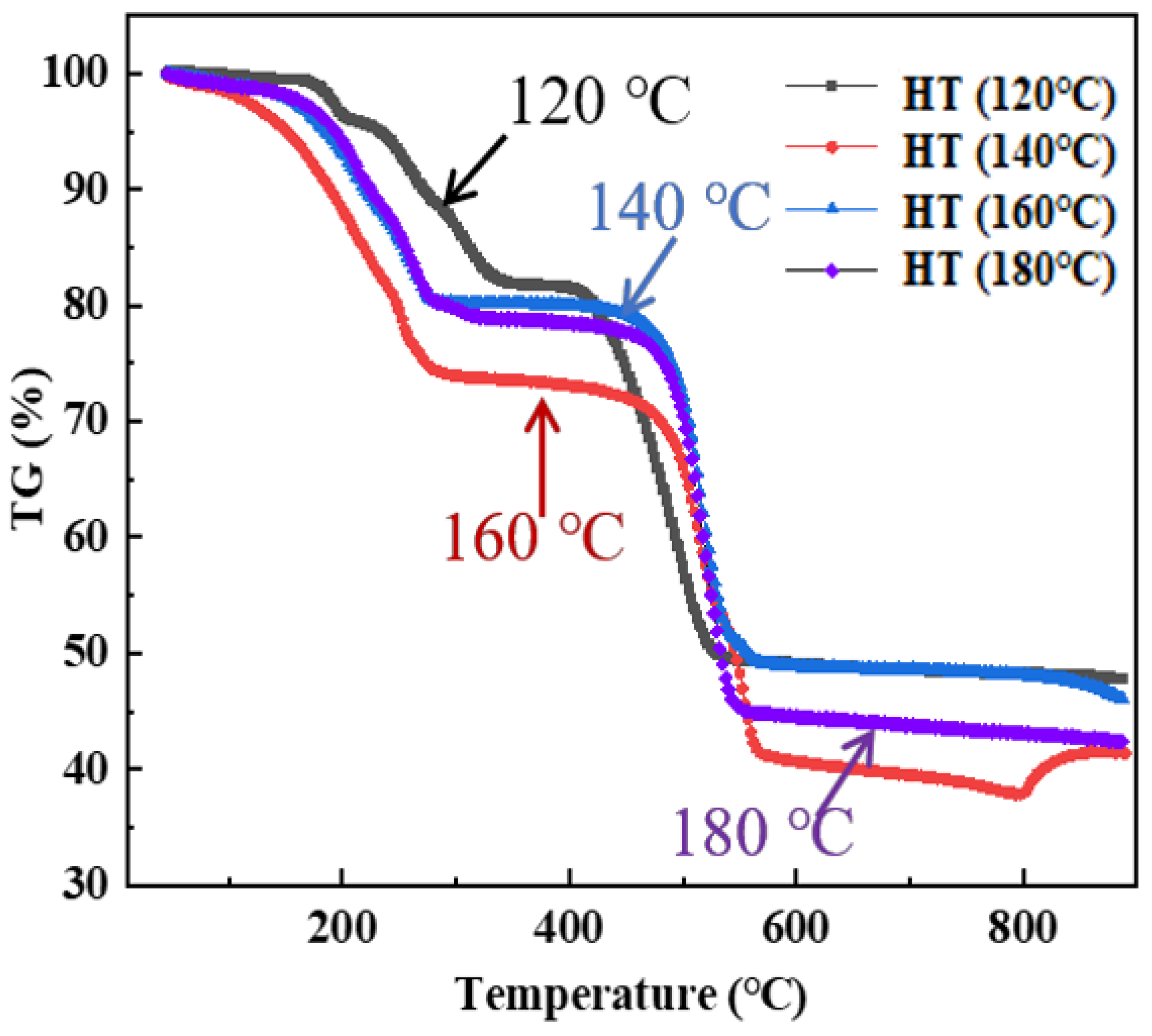



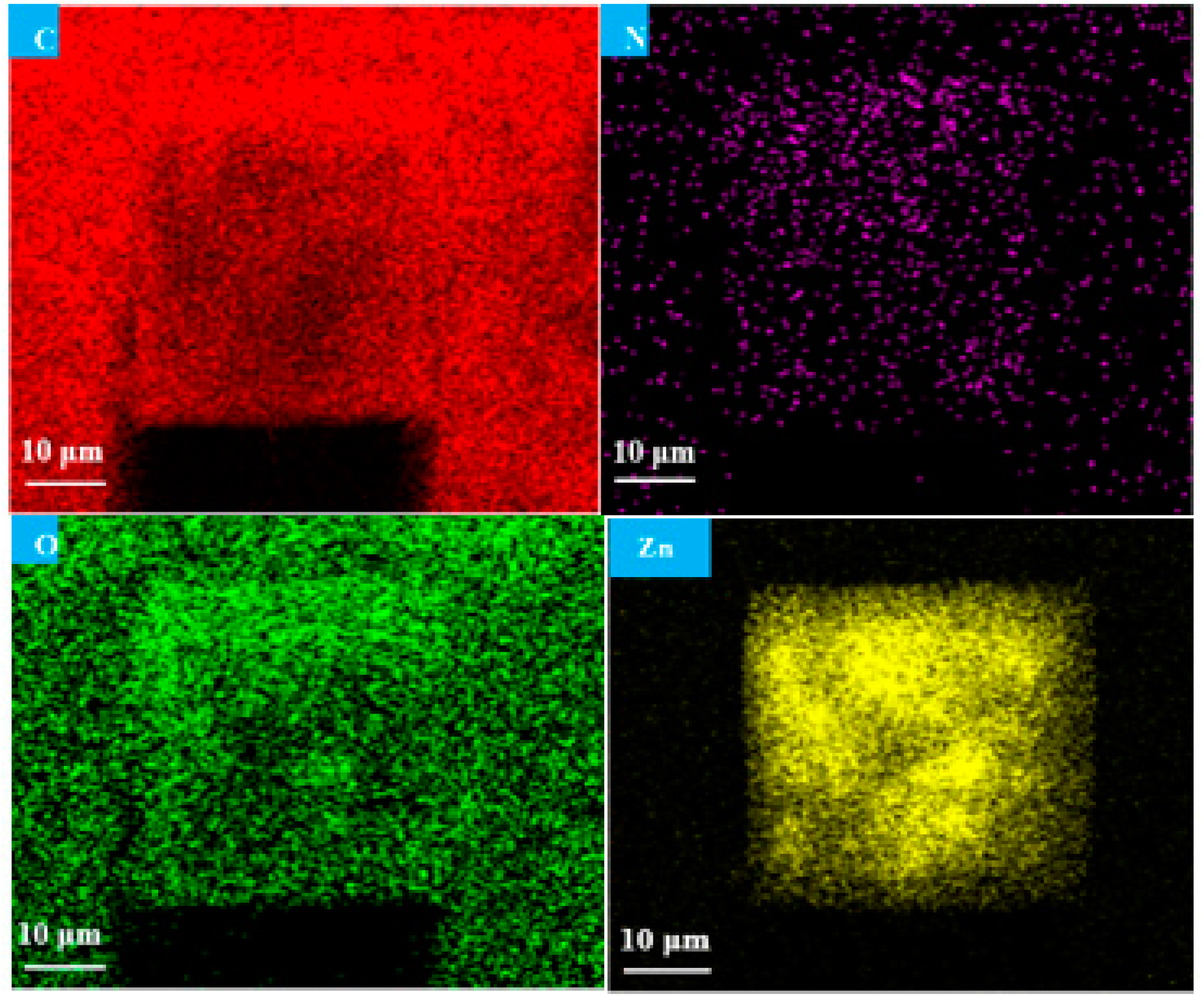
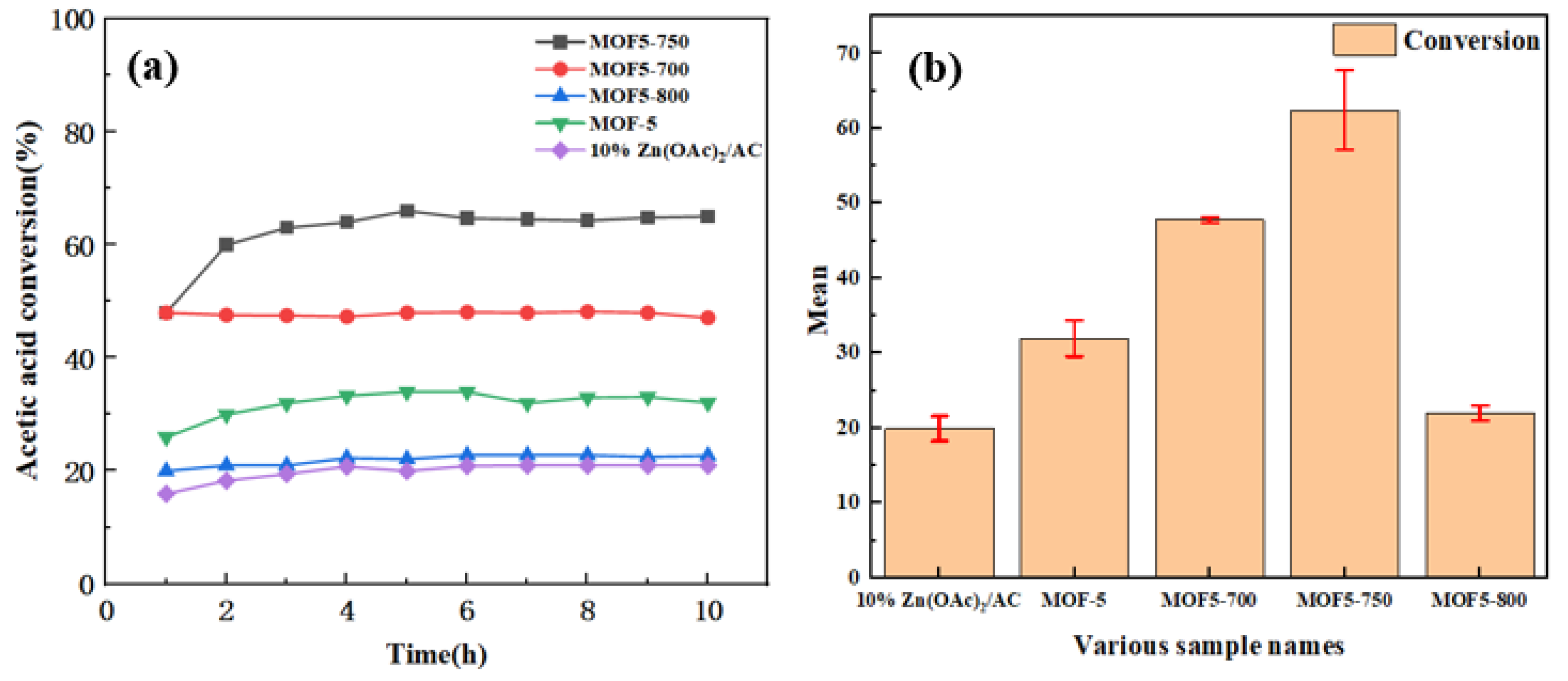

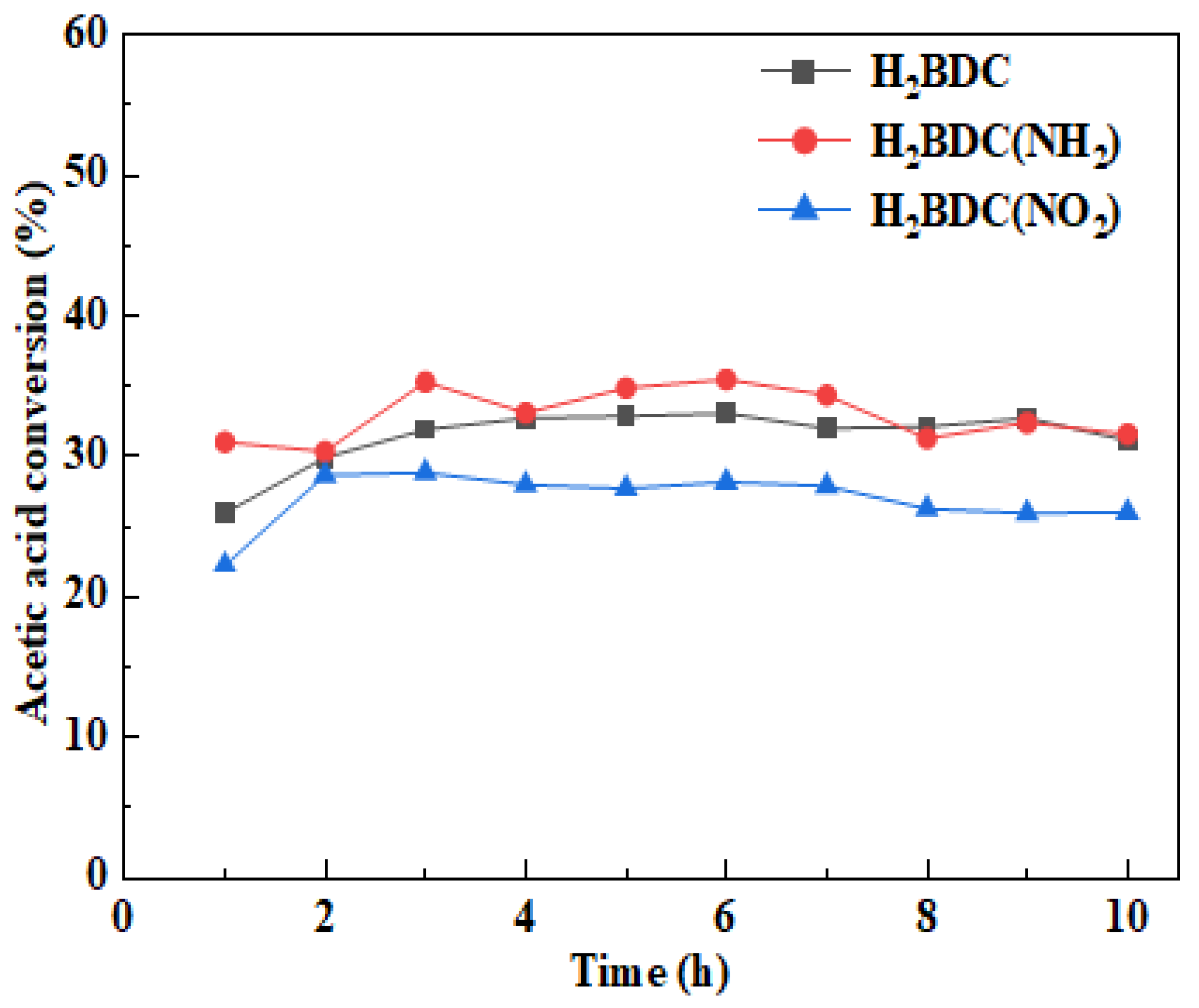
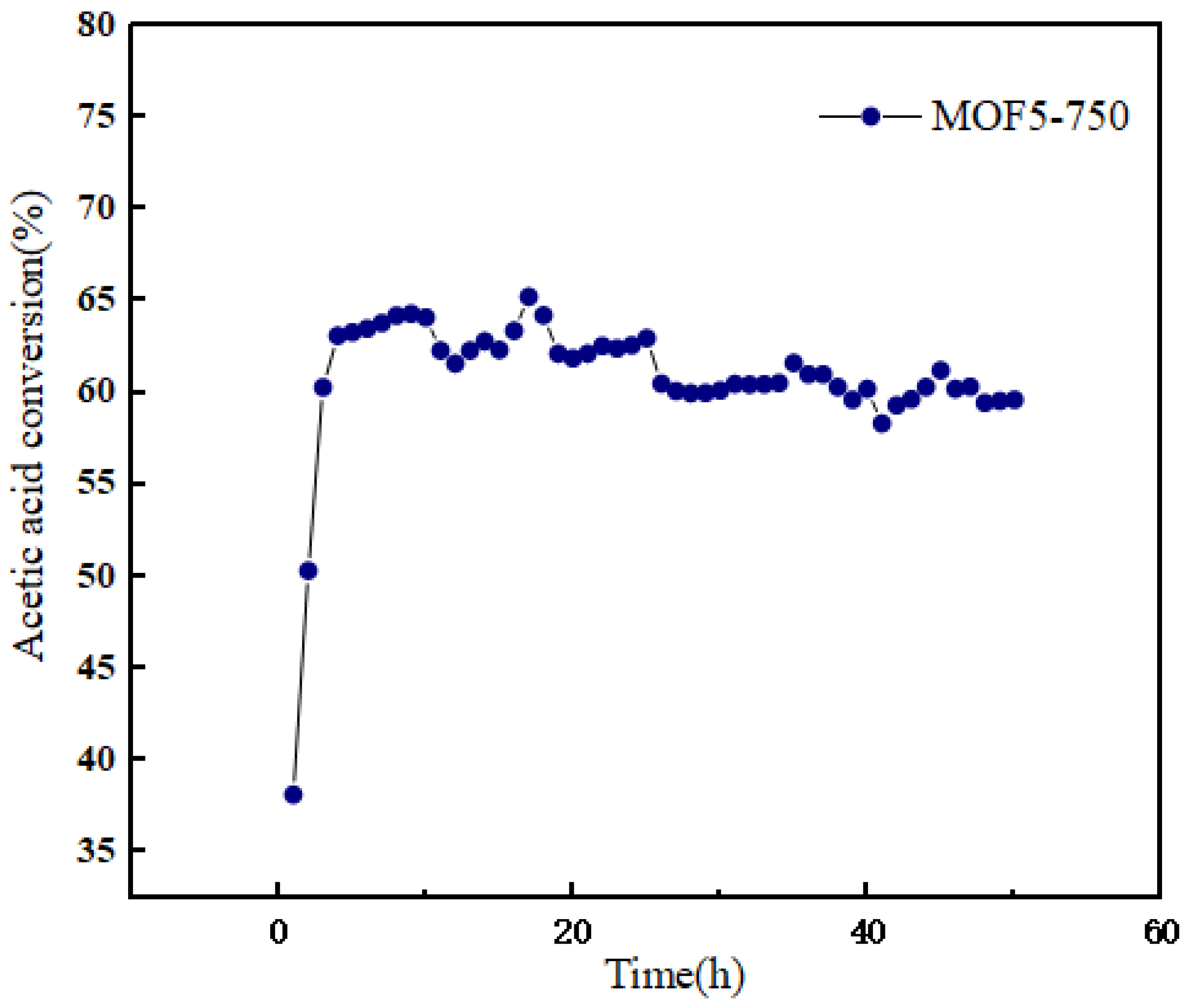
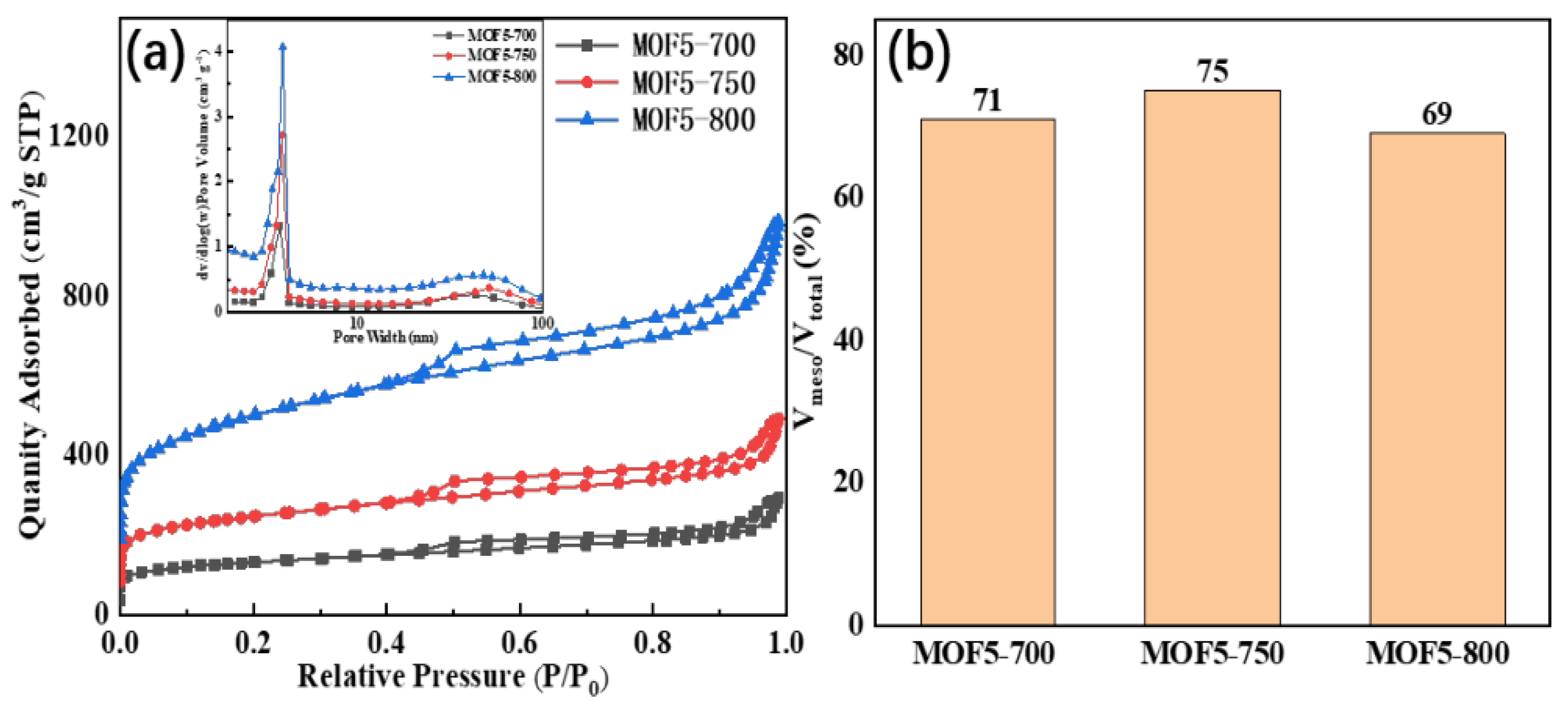
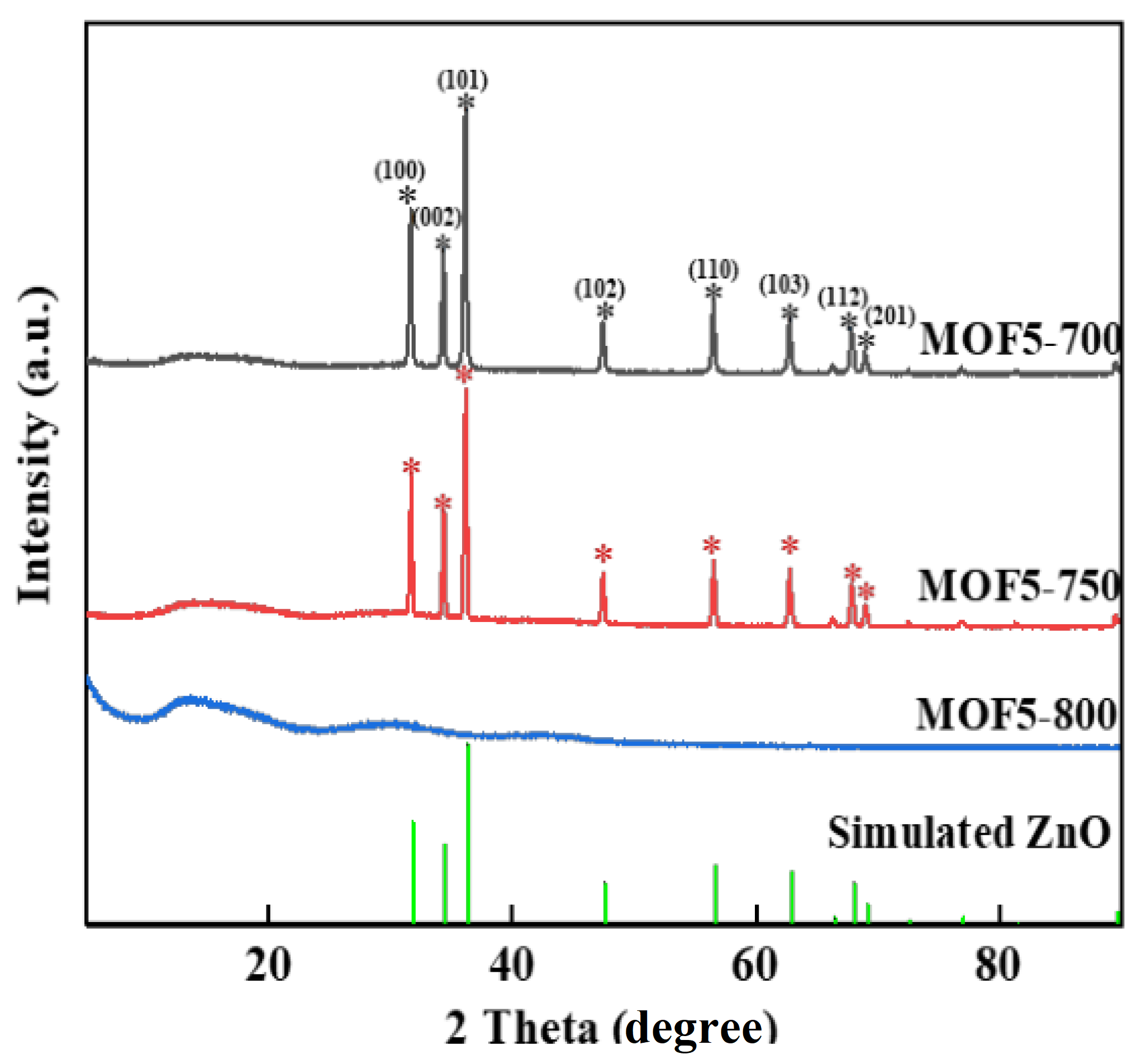
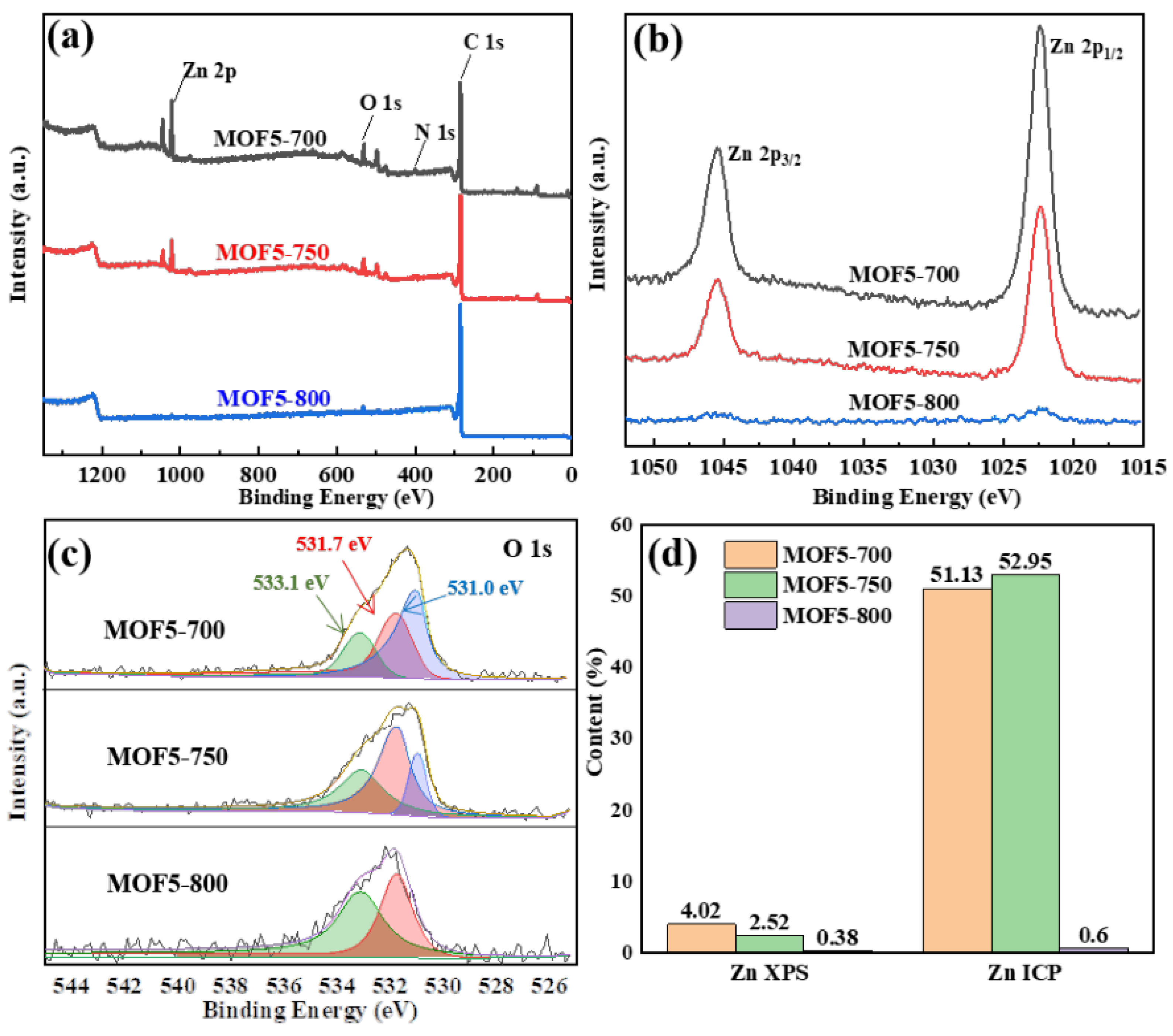
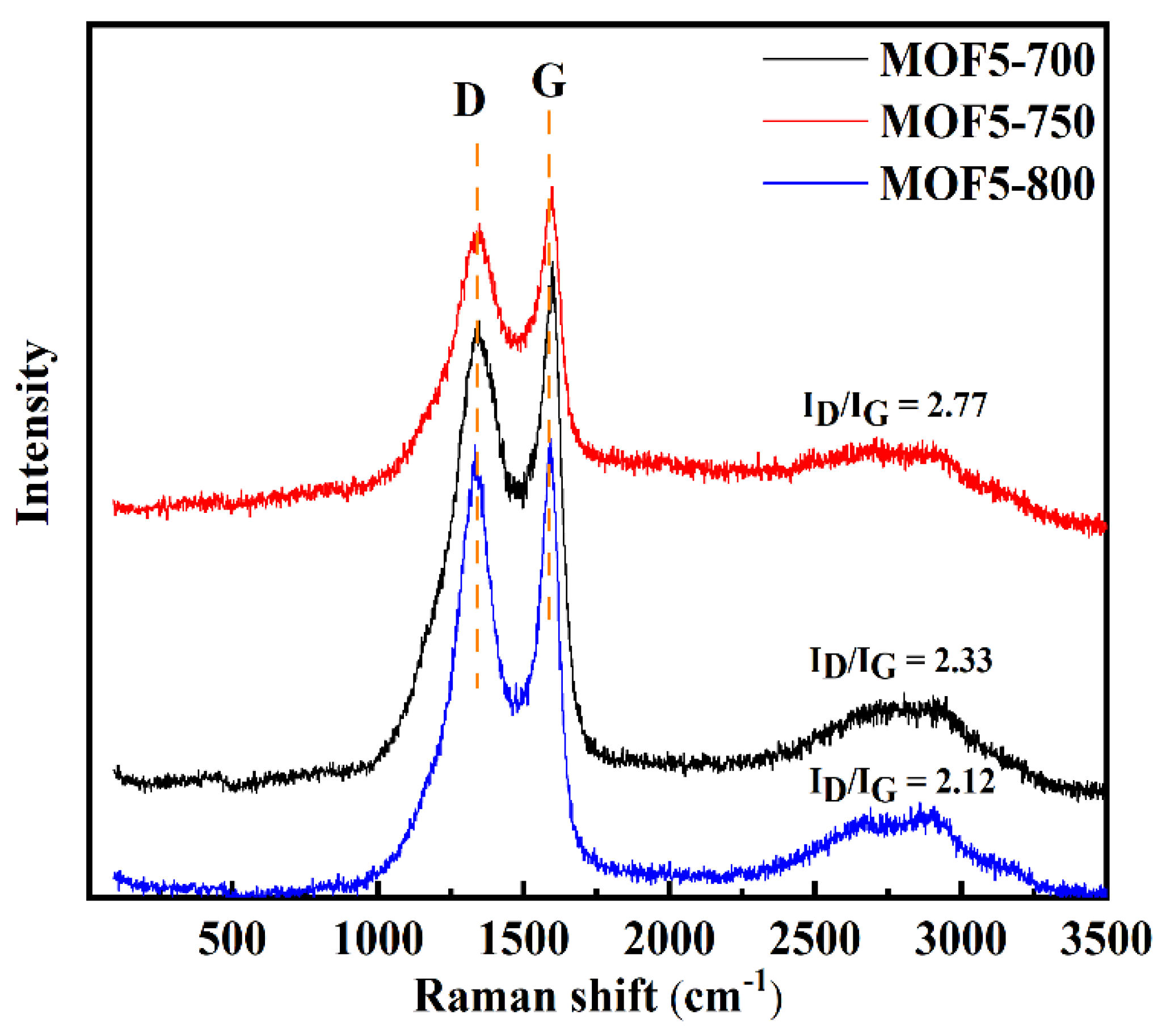
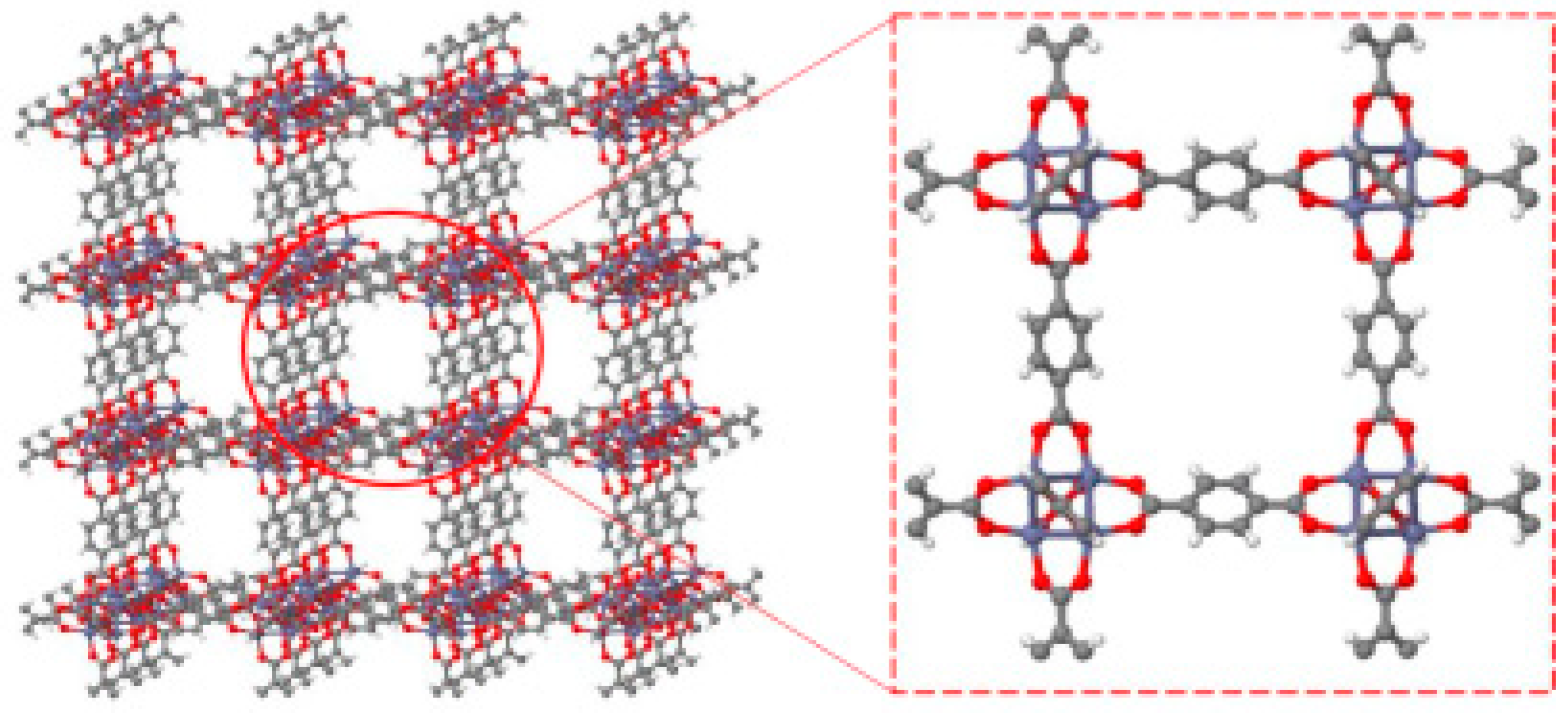

| Samples | BET Surface Area m2/g | Pore Volume cm3/g | Pore Size nm |
|---|---|---|---|
| MOF5-750 HT (120 °C) | 306.89 | 0.19 | 4.67 |
| MOF5-750 HT (140 °C) | 1149.44 | 0.87 | 6.36 |
| MOF5-750 HT (160 °C) | 606.61 | 0.41 | 7.42 |
| MOF5-750 HT (180 °C) | 508.23 | 0.34 | 4.73 |
| Testing Materials | Mean(M) | Standard Deviation (SD) |
|---|---|---|
| 10% Zn (OAc)2/AC | 19.95 | 1.65 |
| MOF-5 | 31.95 | 2.40 |
| MOF5-700 | 47.78 | 0.38 |
| MOF5-750 | 62.43 | 5.32 |
| MOF5-800 | 22 | 0.99 |
| Samples | BET Surface Area m2/g | Pore Volume cm3/g | Pore Size nm |
|---|---|---|---|
| MOF-5 | 301.40 | 0.33 | 6.26 |
| MOF5-700 | 443.95 | 0.33 | 6.44 |
| MOF5-750 | 1149.44 | 0.87 | 6.36 |
| MOF5-800 | 1709.15 | 1.06 | 5.34 |
Disclaimer/Publisher’s Note: The statements, opinions and data contained in all publications are solely those of the individual author(s) and contributor(s) and not of MDPI and/or the editor(s). MDPI and/or the editor(s) disclaim responsibility for any injury to people or property resulting from any ideas, methods, instructions or products referred to in the content. |
© 2023 by the authors. Licensee MDPI, Basel, Switzerland. This article is an open access article distributed under the terms and conditions of the Creative Commons Attribution (CC BY) license (https://creativecommons.org/licenses/by/4.0/).
Share and Cite
Shen, G.; Li, M.; Chen, Y.; Xu, Z.; Wang, X.; Dai, B. Effect of Pyrolysis Conditions on the MOFs-Derived Zinc-Based Catalysts in Acetylene Acetoxylation. Catalysts 2023, 13, 532. https://doi.org/10.3390/catal13030532
Shen G, Li M, Chen Y, Xu Z, Wang X, Dai B. Effect of Pyrolysis Conditions on the MOFs-Derived Zinc-Based Catalysts in Acetylene Acetoxylation. Catalysts. 2023; 13(3):532. https://doi.org/10.3390/catal13030532
Chicago/Turabian StyleShen, Guowang, Mengli Li, Yuhao Chen, Zhuang Xu, Xugen Wang, and Bin Dai. 2023. "Effect of Pyrolysis Conditions on the MOFs-Derived Zinc-Based Catalysts in Acetylene Acetoxylation" Catalysts 13, no. 3: 532. https://doi.org/10.3390/catal13030532
APA StyleShen, G., Li, M., Chen, Y., Xu, Z., Wang, X., & Dai, B. (2023). Effect of Pyrolysis Conditions on the MOFs-Derived Zinc-Based Catalysts in Acetylene Acetoxylation. Catalysts, 13(3), 532. https://doi.org/10.3390/catal13030532






